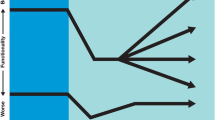Abstract
The process of coma emergence is defined and important issues are identified. Rehabilitative goals for persons emerging from coma are best served by a focus on their response capabilities, rather than sensory stimulation. A method called “response system analysis” is described to guide assessment and treatment of response capabilities.
Similar content being viewed by others
References
Arts, W., Van Dongen, H., Van Hof-Van Duin, J., and Lammens, E. (1985). Unexpected improvement after prolonged postraumatic vegatative state.J. Neurol. Neurosurg. Psychiat. 48: 1300–1303.
Cole, M., and Cole, S. (Eds.). (1979).The Making of Mind: A Personal Account of Soviet Psychology. Harvard University Press, Cambridge, Massachusetts.
Gianutsos, R. (1987).Computer Programs for Cognitive Rehabilitation: Vol. 5. Software Tools for Use with the Individual Emerging from Coma into Consciousness. Life Science Associates, Bayport, New York.
Gianutsos, R., Perlin, R., Mazerolle, K., and Trem, N. (1989). Rehabilitative optometric services for persons emerging from coma.J. Head Trauma Rehab. 4: 17–25.
Gianutsos, R., and Ramsey, G. (1987).Enabling the survivors of brain injury to receive rehabilitative optometric services.Journal of Vision Rehabilitation 2: 37–58.
Hagen, C., Malkmus, D., and Durham, P. (1979). Levels of cognitive functions. InRehabilitation of the Head Inured Adult: Comprehensive Physical Management. Professional Staff Association of Ranchos Los Amigos Hospital, Downey, California.
Haig, A. J., Katz, R. T., and Sahgal, V. (1987). Mortality and complications of the locked-in syndrome.Arch. Physical Med. Rehabil. 68: 24–27.
Jennett, B., and Teasdale, G. (1981).Management of Head Injuries. F. A. Davis, Philadelphia.
Plum, F., and Posner, J. B. (1972).The Diagnosis of Stupor and Coma (2nd ed.). F. A. Davis, Philadelphia.
Rappaport, M. (1985). Evoked potentials. In R. C. W. Hall and T. P. Beresford (Eds.),Handbook of Psychiatric Diagnostic Procedures. Spectrum, New York.
Rappaport, M., Hall, K., Hopkins, K., Belleza, T., Berrol, S., and Reynolds, G. (1977). Evoked brain potentials and disability in brain-damaged patients.Arch. Physical Med. Rehabil. 5: 333–338.
Rappaport, M., Hall, K. M., Hopkins, K., Belleza, T., and Cope, D. N. (1982). Disability Rating Scale for severe head trauma: Coma to community.Arch. Physical Med. Rehabil. 63: 118–123.
Trem, M., Giguere, A., Burke, M., and Gianutsos, R. (1987).Beyond Mental Status: Introducing the Cognitive Participation Rating Scale: Reliability and Validity of an Index of Traumatic Brain Injury Rehabilitation. Paper presented to the American Congress of Rehabilitation Medicine, Orlando, Florida.
Author information
Authors and Affiliations
Rights and permissions
About this article
Cite this article
Gianutsos, R. Response system analysis: What the neuropsychologist can contribute to the rehabilitation of individuals emerging from coma. Neuropsychol Rev 1, 21–30 (1990). https://doi.org/10.1007/BF01108857
Issue Date:
DOI: https://doi.org/10.1007/BF01108857




